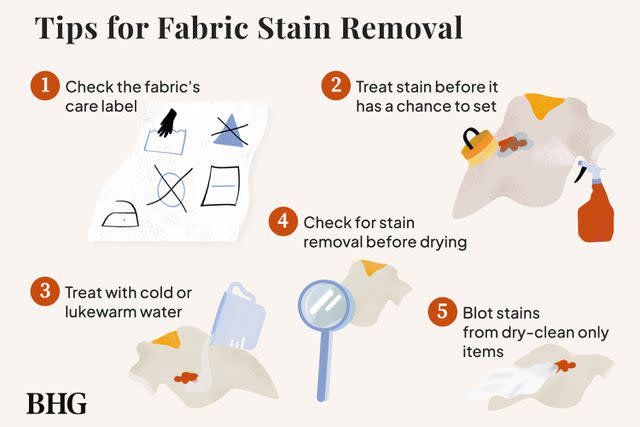The Ultimate Guide to Removing Every Type of Fabric Stain from Clothing

Learn how to get stains out of both machine-washable and nonwashable fabrics using our simple tips.

You can learn how to get stains out of white clothes and colors, no matter the fabric. While stains on clothing and linens can be annoyingly stubborn, they don't have to remain a permanent feature. Even notoriously difficult stains like red wine or ink can be removed from most fabrics.
For all fabric stains, it's important to act fast and treat the spot immediately or as quickly as possible. It's also generally best to blot the stain rather than rub it. Blotting helps draw the stain out of the fabric while rubbing pushes the stain deeper and can damage fibers. No matter which stain removal method you choose, take the time to test it on an inconspicuous part of the garment (for example, a seam allowance) before proceeding. This will let you know whether the cleaning method will damage the fabric.

BHG / Michela Buttignol
The stain removal instructions for washable fabrics—including acrylic, burlap, cotton, denim, linen, nylon, polyester, and spandex—are fairly straightforward. Other materials—such as acetate, fiberglass, rayon, silk, triacetate, and wool—typically shouldn't be washed, but it's still possible to get the spots out with a few tricks. Follow our guide below to learn how to remove stains, even the toughest offenders.

Fabric Stain Removal Tips
Before you begin treating a stain, check the fabric's care label for helpful information on fiber content and recommended care, including the water temperature recommended. For washable items, treat the stain as quickly as possible, before it has a chance to set. Use the recommended cleaning method for that particular type of stain (outlined below). Usually, these treatment methods will recommend cold or lukewarm water, as hot water often sets stains. Similarly, you should always check a wet garment to see if the stain is gone before putting it in the dryer. The heat of the dryer can set the stain and make it permanent.
If the item is marked "dry-clean only," blot off the excess stain and take the item to a professional dry cleaner as soon as possible. Be sure to point out the stain and explain what it is when you drop it off. You should also consider dry cleaning even for technically washable fabrics if the stained item is a favorite piece, or was an expensive purchase.

How to Remove Blood Stains from Clothes
When to treat a bloodstain: Right away, if possible, sponge a wet bloodstain with cold water.
How to treat machine-washables: For fresh stains, soak in cold water, then launder. For dried stains, pretreat or soak in warm water with a product containing enzymes, then launder. These types of laundry products are often recommended for protein-based stains, such as blood. Check the labels for this ingredient, as most enzyme products will promote their ability to remove these stains.
How to treat nonwashables: Flush the stain with cold water. Apply diluted white vinegar to the stain with an eyedropper. Rinse the spot with cool water.
How to Treat Chocolate Stains on Fabric
When to treat a chocolate stain: As soon as possible.
How to treat machine-washables: Pretreat in warm water with a product containing enzymes. Or treat with a prewash stain remover (Target) before laundering. If the stain remains, rewash the item with bleach that's safe for the fabric.
How to treat nonwashables: Apply diluted white vinegar to the stain with an eyedropper. Flush the spot with cool water.
Removing Coffee or Tea Stains on Fabric
When to treat a coffee or tea stain: Sponge with cold water right away, if possible.
How to treat machine-washables: Soak the stain in cool water. Pretreat with a prewash stain remover, a liquid laundry detergent, or a paste of detergent and water. Launder with chlorine bleach, if safe for the fabric, or color-safe bleach (Target).
How to treat nonwashables: Apply diluted white vinegar to the stain with an eyedropper. Flush the spot with cool water.
How to Get Powdered Cosmetics Out of Clothing
When to treat a cosmetics stain: As soon as possible.
How to treat machine-washables: Lightly brush off as much powder from the garment as possible. Pretreat with stain remover or liquid laundry detergent. Launder using the hottest water safe for the fabric.
How to treat nonwashables: Lightly brush off as much powder from the garment as possible, then take it to a professional dry cleaner.

How to Remove Grass Stains on Clothing
When to treat a grass stain: As soon as possible.
How to treat machine-washables: Pretreat them with a stain remover or liquid laundry detergent. Launder using the hottest water safe for the fabric.
How to treat nonwashables: Apply diluted white vinegar to the stain with an eyedropper. Flush the spot with cool water.
How to Get Grease and Oil Stains Out of Clothing
When to treat a grease or oil stain: As soon as possible.
How to treat machine-washables: Work liquid dish soap into the stain with a clean cloth. You can also use a pretreatment stain remover before laundering with hot water. This method also works to get oil stains out of jeans.
How to treat nonwashables: Take to a professional dry cleaner, or follow these instructions for specific fabrics.
Tips for Treating Ink Stains on Fabric
When to treat an ink stain: As soon as possible.
How to treat machine-washables: Pretreat with stain remover and launder as usual. If the stain remains, place the item on clean paper towels. Sponge the area around the stain with denatured alcohol before applying the solvent to the stain. Frequently replace the paper towels as they get soaked. Rinse well and launder.
As an alternative method, working from the back, place the stained fabric over the mouth of a jar or glass. Hold the fabric taut so the ink spot doesn't spread. Drip alcohol through the stained fabric. As the solvent leaves the fabric, the ink will drop into the container. Rinse well and launder.
How to treat nonwashables: Make a solution of 1 part glycerin, 1 part clear dishwashing detergent, 8 parts water, and a few drops of white vinegar. Apply to the stain. Let stand 30 minutes, adding more solution to keep the stain moist. Rinse.
How to Remove Juice Stains on Fabric
When to treat a juice stain: As soon as possible.
How to treat machine-washables: Soak the garment in cold water for 30 minutes. Lightly apply white vinegar to the stain. Let it sit for another 30 minutes. Launder with bleach.
How to treat nonwashables: Take to a professional dry cleaner.
Treating Fabric Stains from Lipstick and Other Oil-Based Makeup Stains
When to treat a lipstick stain: As soon as you're able, apply treatment.
How to treat machine-washables: Do not use water. Blot mineral oil onto the stain, and let the treated item sit for 15 minutes. Blot the excess oil, then sponge with 1 part ammonia and 2 parts water. Rinse thoroughly.
How to treat nonwashables: Treat nonwashable items, except wool or silk, the same way as washables. Wool and silk cannot be treated with ammonia and must be dry-cleaned.

How to Get Mold Stains Out of Clothes
When to treat a mold stain: As soon as possible.
How to treat machine-washables: Scrape off as much mold from the surface as possible by gently brushing with a clean toothbrush. For white items, mix together 1 part bleach with 3 parts water and apply the solution to the stain. Let it sit for several minutes, then wash in the hottest water temperature recommended for the fabric. To treat mold stains on colored clothing, spray white vinegar directly onto the stain or cover it with a clean cloth soaked in vinegar, letting it soak in for several minutes. If possible, let the garment air dry in direct sunlight, which can also help kill mold spores. Repeat this process as needed, then launder as usual. If the stain persists, take the item to a professional dry cleaner.
How to treat nonwashables: Take to a professional dry cleaner.
How to Remove Nail Polish on Clothes or Linens
When to treat a nail polish stain: As soon as possible.
How to treat machine-washables: Immediately scrape off any excess nail polish with a dull knife or spatula. Take care not to smear the polish as you scrape. Take to a professional dry cleaner, or place the stain facedown on several layers of clean paper towels. Apply polish remover to the back of the stain. Replace the towels as they accept the polish. Repeat if the stain begins to lift. Rinse and launder.
How to treat nonwashables: Immediately scrape off any excess nail polish with a dull knife or spatula. Take care not to smear the polish as you scrape. Take to a professional dry cleaner.
Removing Oil-Based Paint Stains on Fabric
When to treat an oil-based paint stain: As soon as possible.
How to treat machine-washables: If the label on the paint recommends a thinner, use that solvent for stain removal, or try turpentine (The Home Depot). Rinse and launder.
How to treat nonwashables: Blot excess stain and take the fabric to a dry cleaner.
How to Get Water-Based Paint Out of Fabric
When to treat a water-based paint stain: Rinse in warm water right away.
How to treat machine-washables: Rinse in warm water while the stain is still wet. Launder.
How to treat nonwashables: Sponge the wet stain with warm water, then blot with a diluted dishwashing soap solution and rinse.

How to Remove Sweat Stains on Clothing
When to treat a perspiration stain: As soon as possible.
How to treat machine-washables: Apply ammonia to fresh stains, or white vinegar to old stains; rinse. Launder using the hottest water safe for the fabric, or wash with an enzyme product or color-safe bleach. (Never mix ammonia and bleach.)
To get sweat stains out of white shirts, mix equal parts of baking soda, hydrogen peroxide, and water to form a paste. Rub the mixture into the stain, let it rest for at least an hour, then wash as usual. Hydrogen peroxide is a natural bleaching agent, so this method should only be used for white fabrics.
How to treat nonwashables: Apply diluted white vinegar to the stain with an eyedropper. Flush the spot with cool water. This method works well to get sweat stains out of hats.
How to Treat Red Wine Stains on Clothes and Linens
When to treat a red wine stain: Right away, blot with a clean, dry cloth.
How to treat machine-washables: Cover the stain with salt and stretch the fabric over a bowl. Pour boiling water onto the stain. Launder. If stain remains, apply diluted white vinegar with an eyedropper. Flush with cool water and launder.
How to treat nonwashables: Apply diluted white vinegar to the stain with an eyedropper. Flush the spot with cool water.
Tip for Treating Fabric Stains from Sauces
When to treat a sauce stain: If possible, sponge with cold water right away.
How to treat machine-washables: Apply diluted white vinegar to the stain with an eyedropper. Flush the spot thoroughly with cool water. Pretreat with a prewash stain remover and launder.
How to treat nonwashables: Apply diluted white vinegar to the stain with an eyedropper. Flush the spot with cool water.
How to Get Rid of Turmeric Stains on Fabric
When to treat a turmeric stain: Right away, if possible, rinse with cold water.
How to treat machine-washables: Soak the item in a solution of cool water and laundry detergent for 20 minutes. If the fabric is bleach-safe, soak in a diluted bleach solution instead. Launder it immediately in a cold-water cycle, using regular detergent. If possible, air dry the item in the sun to help fade the turmeric, then wash again.
How to treat nonwashables: Flush the spot with cool water. If the stain persists, take the garment to a professional dry cleaner.
Frequently Asked Questions
What stains cannot be removed from clothes?
Any type of permanent marker will not come out of clothing, sheets, or towels, though it may fade after many washings. If a stain has set in the fabric for a while without treatment, it may not be removable, especially if it's a grease or oil-based product like salad dressing and many cosmetics. The best way to prevent stains from becoming permanent is to treat them immediately.
What are the best stain removers?
There are many very effective stain-removing products on the market. Some may be better for natural fabrics while others are more effective on synthetics. The best overall stain remover for most fabrics and stains is a 50-50 mix of white vinegar and water. Keep a spray bottle of this mixture on hand for quick treatment of most household stains.
For more Better Homes & Gardens news, make sure to sign up for our newsletter!
Read the original article on Better Homes & Gardens.

